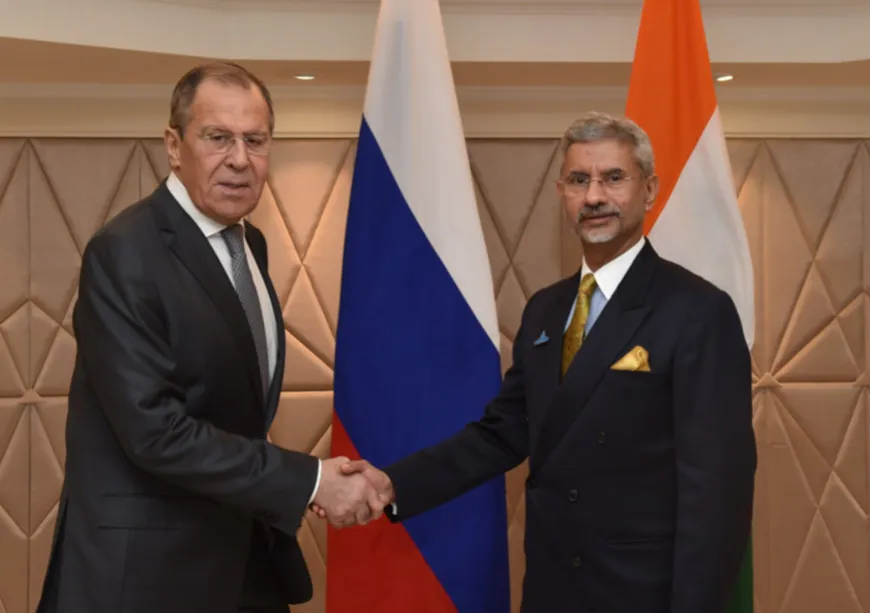
On 25 December, India’s External Affairs Minister Dr S. Jaishankar went on a five-day tour of Russia with a wide-ranging programme of diplomatic, economic, and cultural engagements in Moscow and Saint Petersburg.
The perception of India-Russia ties’ status has become a test of optimistic-pessimistic bias. The optimistic observers tend to trust in an ever-green friendship between the two countries, a remarkable steadiness of bilateral ties, and a mutual interest in maintaining the balance of power in Eurasia that naturally ties their geopolitical visions together. The sceptics argue that steady relations have turned stagnant while convergences between the two are shrinking, specifically as both increasingly tilt toward each other’s rivals—the United States (US) and China.
Jaishankar’s visit to Russia was atypical on many accounts. First, a lengthy stay in Russia, including a call on President Vladimir Putin, is a rare practice for Indian officials, especially after February 2022. Second, even though the visit was scheduled well in advance, it was announced by the Government of India only on the eve of it. This goes in line with a post-Ukraine trend, with some of India’s diplomatic and military contacts with Russia being concealed or holding a semi-official status. Third, the visit resulted in signing three agreements—on building new units of the Kudankulam Nuclear Power Plant; on cooperation in pharma and healthcare; and on consultations between the ministries of foreign affairs in 2024-2028—though all of these topics were only given a passing mention without further details. Fourth, Jaishankar diverted much attention to conversations with Russian experts and scholars in Moscow and Saint Petersburg, which could prompt new openings in academic ties between the two countries.
The optimistic observers tend to trust in an ever-green friendship between the two countries, a remarkable steadiness of bilateral ties, and a mutual interest in maintaining the balance of power in Eurasia that naturally ties their geopolitical visions together.
With no annual summit for the second year in a row, Jaishankar’s visit was arguably aimed at reassuring the Russian leadership that India was not turning its back on Russia. Many shibboleths of India-Russia meetings, like those on “strategic convergence”, “mutually beneficial” works, shared geopolitical interests, and pursuing multipolarity, might create an impression that the political affinity between the two states is back on track. The reality, however, seems more complicated.
Although India’s multi-alignment policy and Russia’s quest for bypassing isolation from the West dictate keeping in close touch, New Delhi and Moscow are finding it extremely difficult to narrow the widening gap of their strategic outlooks. When speaking with Dr Jaishankar about the war in Ukraine, Putin had to mince words and refer to it as “the current turbulences in the world” and “hot spots”. The Russian President demonstrated his eagerness to provide New Delhi with “additional information” on “the situation in Ukraine”, apparently hoping to influence Prime Minister Narendra Modi’s viewpoint. It looks rather naïve since India’s stance on Ukraine has been one of studied neutrality. It is no coincidence that a few days after his Russia trip, Jaishankar held a phone conversation with his Ukrainian counterpart Dmytro Kuleba and not only lent an ear to Kyiv’s perspective on the war but also “discussed advancing bilateral cooperation”, including a possible rejuvenation of the India-Ukraine intergovernmental commission.
The Indo-Pacific is another geography where India and Russia are speaking in different languages. Russia’s Foreign Minister Sergey Lavrov, during the presser, was speaking in vague language about “the processes in the Asia-Pacific” and Russia’s disquiet with the regional situation developing “contrary to the agreements reached at ASEAN.” This was apparently yet another veiled rebuke to the Quad and AUKUS , which points to a persisting divergence of regional visions between Moscow and New Delhi.
Russia’s Foreign Minister Sergey Lavrov, during the presser, was speaking in vague language about “the processes in the Asia-Pacific” and Russia’s disquiet with the regional situation developing “contrary to the agreements reached at ASEAN.”
For the time being, the two have discovered a lucrative niche in energy partnership. Imports of Russian crude have been useful to New Delhi for alleviating inflation, spurring industrial development, and setting up oil products’ exports to Europe and have allowed Moscow to replenish their budget. This arrangement led to unprecedented volumes of India-Russia trade, which amounted to almost US$ 50 billion in FY2022-2023 (https://tradestat.commerce.gov.in/eidb/default.asp) and will most likely bypass this mark in FY2023-2024. The numbers from an emergent grey market between the two countries may further add up several billions of dollars to the trade turnover.
The development of economic ties beyond the energy partnership is still riddled with limitations. The non-oil trade takes up only one-fifth of the total trade turnover . India’s oil imports from Russia are prone to fluctuations and may be sweepingly curtailed if the price is unfavourable for Indian refineries. The imbalance in India’s trade with Russia is so profound that it has prevented the countries from establishing a working settlement of Rupee-denominated trade . The utilisation of alternative currencies like the Dirham and Yuan brings exposure to other risks and cannot become a permanent solution. With India’s exports to Russia fluctuating at around US$3-4 billion, reaching a free trade agreement between India and Eurasian Economic Union (EAEU)—a topic for the renewed talks that is seven years overdue—does not appear to be viable. As India expects better market access for its products, Moscow insists it would be possible only after India’s joining the EAEU free trade zone. This puts bilateral trade in a proverbial catch-22, with bleak prospects of India’s exports taking off. The threat of secondary sanctions is another matter many Indian businesses would not want to mess with. Contrary to conventional wisdom, the lack of sufficient connectivity is not a primary hindrance. The India-Russia trade is booming owing to sea-borne supplies. The improvement of The International North–South Transport Corridor’s (INSTC) railway infrastructure may be desirable for some cargoes like perishable freight but is hardly a major prerequisite for trade growth.
With India’s exports to Russia fluctuating at around US$3-4 billion, reaching a free trade agreement between India and Eurasian Economic Union (EAEU)—a topic for the renewed talks that is seven years overdue—does not appear to be viable.
The complexities India and Russia are struggling with were best encapsulated in EAM Jaishankar’s response at the meeting with the Indian community in Moscow: “Right now is a very unusual situation. We all know why it is an unusual situation. But the fact is that […] we are trying today to find ways by which [our] banks deal with each other.” As almost two years of this ‘unusual situation’ have passed, the pressing question is to what extent India is interested and resolved to push its economic ties with Russia forward.
India does not seem keen to invest in the partnership at a level that may disrupt its engagements with key Western partners. New Delhi realises Moscow can still be a dangerous spoiler, particularly if merged with Beijing, so abandoning and antagonising Russia is not to India’s advantage. At the same time, Russia is not a decisive player for India’s economic growth. With or without Moscow on board, India will continue to rise in the years to come, having an array of partners and investors in critical spheres. So, New Delhi’s intention to keep the relationship with Russia running is more about being on the safe side, particularly as a soaring US-China rivalry can get out of control. Fending off the disruption of ties with Moscow prevails for New Delhi over making headway in dealings.
As long as Russia is at war and under sanctions, the most probable scenario is that a large part of bilateral deals will be stuck in the middle and eventually will not work out. Even as India and Russia send signals of maintaining close ties, it is hard to expect any makeover of the relationship.
Aleksei Zakharov is a Visiting Fellow with the Strategic Studies Programme at the Observer Research Foundation
The views expressed above belong to the author(s). ORF research and analyses now available on Telegram! Click here to access our curated content — blogs, longforms and interviews.




 PREV
PREV


